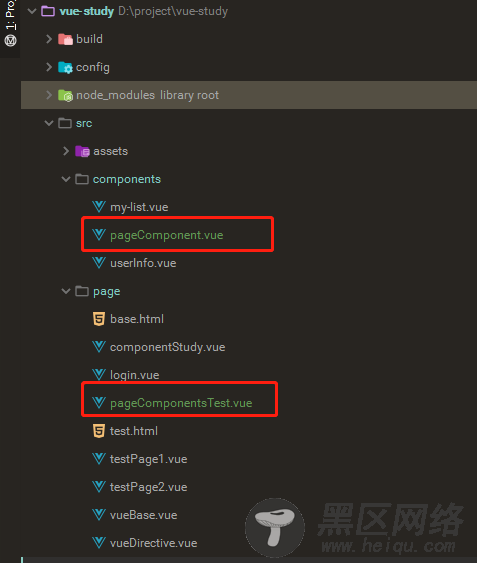今天用vue来实现一个分页组件,总体来说,vue实现比较简单,样式部分模仿了elementUI。所有代码的源码可以再github上下载的到:下载地址 先来看一下实现效果:

整体思路
我们先看一下使用到的文件的目录:

我们在 pageComponentsTest.vue 页面引入了 pageComponent.vue 分页组件。整体思路是通过 props
来达到组件的灵活通用的效果,整体语法是使用vue的VM语法。
pageComponent.vue实现
首先实现一个分页,需要知道数据总条数,一个页面显示的数据条数和当前显示第几页的数据。那么我们在 pageComponent.vue 里面的 props 就有了。看下面的代码:
props: { // 分页配置 pageConfig: { type: Object, require: true, default() { return { pageSize: 10, //一页的数据条数 pageNo: 0, //当前页的索引 total: 0, //总的数据条数 pageTotal: 0 //总的页数 } } }
根据用户入参,我们可以使用计算属性来计算一个总页数的变量:
computed: { //计算总页数,如果传了pageTotal,直接取pageTotal的值,如果传了total,那么根据pageSize去计算 pageTotal(){ const config = this.pageConfig if(config.pageTotal){ return config.pageTotal }else { if(config.pageSize && config.total){ return Math.ceil(config.total/config.pageSize) }else { return 0 } } } }
有了总页数,和当前页,就需要各种判断来实现我们的html部分了,这里分4中情况
总页数小于8,只需要直接遍历到8就行了。
总页数大于8,但当前页小于4的。
总页数大于8,当前页靠后的。
总页数大于8,当前页在中间的。
下面看具体的实现:
<!--上一页--> <button @click="prePage" :disabled="currentPage === 1">上一页</button> <!--总页数小于8的--> <template v-if="pageTotal <= showPageNo"> <button v-for="i in pageTotal" @click="changeCurrentPage(i)" :class="{active:i === currentPage}" :key="i">{{i}}</button> </template> <template v-else-if="currentPage < 4"> <button v-for="i in 6" @click="changeCurrentPage(i)" :class="{active:i === currentPage}" :key="i">{{i}}</button> <button :disabled="true">···</button> <button>{{pageTotal}}</button> </template> <template v-else-if="currentPage > pageTotal - 4"> <button>1</button> <button :disabled="true">···</button> <button v-for="i in 6" @click="changeCurrentPage(i + (pageTotal - 6))" :class="{active:(i + (pageTotal - 6)) === currentPage}" :key="i">{{i + (pageTotal - 6)}}</button> </template> <template v-else> <button>1</button> <button :disabled="true">···</button> <button @click="changeCurrentPage(currentPage - 2)">{{currentPage - 2}}</button> <button @click="changeCurrentPage(currentPage - 1)">{{currentPage - 1}}</button> <button>{{currentPage}}</button> <button @click="changeCurrentPage(currentPage + 1)">{{currentPage + 1}}</button> <button @click="changeCurrentPage(currentPage + 2)">{{currentPage + 2}}</button> <button :disabled="true">···</button> <button @click="changeCurrentPage(pageTotal)">{{pageTotal}}</button> </template> <!--下一页--> <button @click="nextPage" :disabled="currentPage === pageTotal">下一页</button>
可以看到页面上需要实现3个方法,分别是上下页,和点击页面的方法。
methods: { prePage(){ this.currentPage -= 1 this.$emit('changeCurrentPage',this.currentPage) }, nextPage(){ this.currentPage += 1 this.$emit('changeCurrentPage',this.currentPage) }, changeCurrentPage(i){ this.currentPage = i this.$emit('changeCurrentPage',this.currentPage) } }
以上就是 pageComponent.vue 的大致实现了,每次页面改变,都会触发一个 changeCurrentPage 方法的回调,用来通知当前使用组件的页面当前页已经改变。
pageComponentsTest.vue的实现
引用页面就比较简单了,只要传入组件需要的对应的参数,就能显示我们的组件了。 引用部分:
<template> <div> <page-component :page-config="pageConfigTotal" @changeCurrentPage="changePage"></page-component> <page-component :page-config="pageConfigPageTotal"></page-component> </div> </template>
配合入参部分:
{ name: "pageComponentsTest", data() { return { pageConfigTotal:{total:21,pageSize:10,pageNo:1}, pageConfigPageTotal:{total:21,pageSize:10,pageNo:1,pageTotal:50} } }, components:{'page-component':pageComponent}, methods: { changePage(page){ this.pageConfigTotal.pageNo = page } } }
总结
